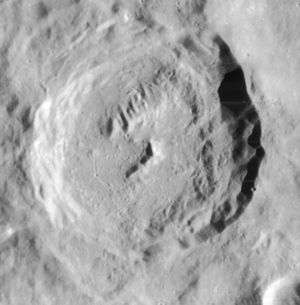Fabricius (crater)
 Lunar Orbiter 4 image | |
| Coordinates | 42°54′S 42°00′E / 42.9°S 42.0°ECoordinates: 42°54′S 42°00′E / 42.9°S 42.0°E |
|---|---|
| Diameter | 78 km |
| Depth | 2.5 km |
| Colongitude | 319° at sunrise |
| Eponym | David Fabricius |
Fabricius is a lunar impact crater that is located within the northeast part of the walled plain Janssen.. At this location, from Earth, the crater appears oval due to foreshortening, but the crater is actually nearly circular. Attached to the north-northwest rim is the slightly larger cater Metius. Fabricius has multiple central peaks that rise to 0.8 km, with a rugged rise to the northwest running north–south. The rim is lumpy and somewhat distended, most noticeably to the southwest and south.[1] It is 78 kilometers in diameter and 2,500 meters deep. It is from the Eratosthenian period, 3.2 to 1.1 billion years ago. It is named after David Fabricius, a 16th-century German astronomer.[2]
Satellite craters
By convention these features are identified on lunar maps by placing the letter on the side of the crater midpoint that is closest to Fabricius.[3]
Located southeast is the smaller Fabricius A, north of that is the smaller Fabricius B which nearly forms a double crater with the smaller circular arc further southeast and to the south nearly the same size is Fabricius J. The first and the third are also forming a rim of the adjacent crater of Janssen.
| Fabricius | Latitude | Longitude | Diameter |
|---|---|---|---|
| A | 44.6° S | 44.0° E | 45 km |
| B | 43.6° S | 44.9° E | 17 km |
| J | 45.8° S | 45.2° E | 16 km |
References
- ↑ Rükl, Antonín (1990). Atlas of the Moon. Kalmbach Books. ISBN 0-913135-17-8.
- ↑ Autostar Suite Astronomer Edition. CD-ROM. Meade, April 2006.
- ↑ Bussey, B.; Spudis, P. (2004). The Clementine Atlas of the Moon. New York: Cambridge University Press. ISBN 0-521-81528-2.
| Wikimedia Commons has media related to Fabricius (crater). |
